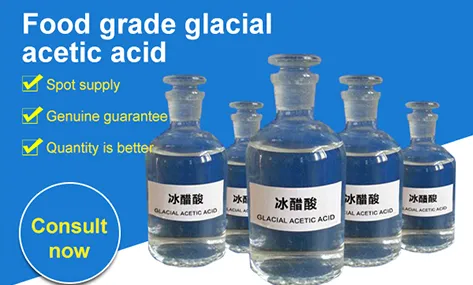
Jul . 10, 2025 14:28 Back to list
The Application of Glacial Acetic Acid in Industrial, Food, Pharmaceutical and Other Fields
In the vast field of organic chemistry, Glacial Acetic Acid has become an indispensable and important raw material due to its unique chemical properties and wide application value. As a pure acetic acid, Glacial Acetic Acid is a colorless and transparent liquid at room temperature, with a strong pungent odor and a combination of corrosiveness and flammability. It is not only a "booster" for the development of many industries, but also a key object of safety management due to potential hazards.

In the field of industrial production, Glacial Acetic Acid can be regarded as the "cornerstone of chemical industry"
In the textile printing and dyeing industry, as an acid-base regulator, it can effectively control the pH value of dyes, help dyes adhere better to fabrics, and improve dyeing effect and color fastness; In the plastic industry, anhydrous acetic acid is a key raw material for producing cellulose acetate, which is widely used in the manufacturing of products such as film and eyeglass frames. In addition, Glacial Acetic Acid is also an intermediate for synthesizing various organic compounds, such as ethyl acetate produced by esterification with ethanol. This product is commonly used in the fields of solvents, fragrances, and coatings, further extending the application chain of Glacial Acetic Acid.
Glacial Acetic Acid also plays an important role in the food industry
Glass acetic that meets food grade standards, after strict purification and quality testing, can be used as an acidity regulator. In the production of vinegar, it is the main source of acidity in artificially synthesized vinegar, and adding it in moderation can give vinegar a rich and mellow taste; Glacial Acetic Acid can adjust the pH value of processed foods such as jam and canned food, inhibit microbial growth, play a natural preservative role, and extend the shelf life of food. Meanwhile, its safe use must strictly comply with food additive standards to ensure consumer health.
The pharmaceutical industry cannot do without the assistance of Glacial Acetic Acid
In the process of drug synthesis, it serves as a solvent or reaction medium to help dissolve insoluble drug components and promote chemical reactions; In topical preparations for dermatology, low concentrations of 1 glacial acetic acid solution have antibacterial and anti itch effects, and can be used to treat skin diseases such as tinea pedis. In addition, Glacial Acetic Acid can also be used as an analytical reagent for acid-base titration in drug quality testing, ensuring the purity and effectiveness of drugs.
The storage and transportation of Glacial Acetic Acid require high attention to safety issues
Due to the corrosive nature of 10 glacial acetic acid, which can burn the skin and corrode metal containers, it is necessary to use corrosion-resistant plastic or glass containers for storage and keep them sealed to prevent volatilization. During transportation, it is necessary to avoid mixing with oxidants and alkaline substances, keep away from sources of fire and high temperature environments, and prevent combustion or explosion. At the same time, operators need to wear professional protective equipment such as chemical protective suits, goggles, and gloves to reduce exposure risks.
In summary, Glacial Acetic Acid, with its diverse application value, is deeply integrated into multiple fields such as industry, food, and medicine, providing important support for economic development and improvement of life. But its corrosiveness and flammability also bring potential risks. Whether it is production enterprises, transportation units or users, they must strictly abide by safety regulations and scientifically control it. Only by balancing its application value and security features can Glacial Acetic Acid continue to play a positive role in various industries, promoting social development and progress.
Glacial Acetic Acid FAQs
What is Glacial Acetic Acid?
Glacial Acetic Acid is anhydrous acetic acid (CH3 COOH) with a purity of over 99%. It is named Glacial Acetic Acid because it solidifies into ice like crystals at low temperatures (melting point of 16.6 ° C).
What is the difference between Glacial Acetic Acid and regular acetic acid?
Ordinary acetic acid is usually an aqueous solution of acetic acid (with a concentration of about 520%), while Glacial Acetic Acid is pure acetic acid, which does not contain water and is more corrosive and acidic.
What are the main uses of Glacial Acetic Acid?
Glacial Acetic Acid is widely used in chemical synthesis (such as preparing acetate esters and drugs), food industry (as an acidity regulator), textile printing and dyeing, as well as solvent or buffer preparation in laboratories.
Why is Glacial Acetic Acid corrosive?
High concentrations of acetic acid can dissociate a large amount of hydrogen ions (H ⁺), which can damage organic tissues (such as skin and mucous membranes). At the same time, its dehydration can exacerbate corrosive effects, so caution should be exercised during operation.
How to securely store Glacial Acetic Acid?
Store in a sealed glass or acid resistant plastic container, away from oxidants and alkaline substances, keep cool and ventilated (avoid high temperatures), and wear protective equipment (gloves, goggles) for handling.
(Note: Glacial Acetic Acid has a pungent odor and should be operated in a fume hood.)
-
The Connection and Value of Acetic Acid
NewsJul.10,2025
-
The Application of Glacial Acetic Acid in Industrial, Food, Pharmaceutical and Other Fields
NewsJul.10,2025
-
Security points of Glacial Acetic Acid Nfpa
NewsJul.10,2025
-
Glacial Ethanoic Acid: The 'Versatile' and 'Dangerous Elf' of the Chemical Industry
NewsJul.10,2025
-
Formation Principle and Special Properties of Frozen Glassy Acetic Acid
NewsJul.10,2025
-
Application of Concentrated Glacial Acetic Acid in Chemical, Pharmaceutical, Food and Other Fields
NewsJul.10,2025
